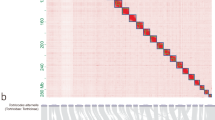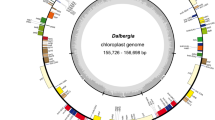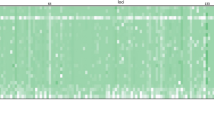Abstract
DNA has been successfully isolated from both fossilized plant1 and animal tissues2–6. The oldest material, dated as 25–40 million years old (Tertiary), was obtained from amber-entombed bees4,5 and termites6. Tissues from both these insects yielded DNA of good quality, which could be amplified by the polymerase chain reaction (PCR) and subsequently sequenced, including the genes encoding 18S ribosomal RNA5,6 and 16S rRNA6. We report here the extraction of DNA from a 120–135-million-year-old weevil (Nemonychidae, Coleoptera) found in Lebanese amber, PCR amplification of segments of the 18S rRNA gene and the internal transcribed spacer, and the corresponding nucleotide sequences of their 315- and 226-base-pair fragments, respectively. These sequen-ces were used for preliminary phylogenetic analysis of the nemonychid's sequence with three extant coleopterans: Lecontellus pinicola (Nemonychidae), Hypera brunneipennis (Curculionidae) and the mealworm Tenebrio molitor (Tenebrionidae), and two extant dipterans: the fruitfly Drosophila melanogaster (Drosophilidae) and mosquito Aedes albopictus (Culicidae) for the purpose of ascertaining the origin of the extracted and amplified DNA. The results revealed that the PCR-amplifted material is that of the extinct nemonychid weevil. This represents the oldest fossil DNA ever extracted and sequenced, extending by 80 million years the age of any previously reported DNA4–6.
This is a preview of subscription content, access via your institution
Access options
Subscribe to this journal
Receive 51 print issues and online access
$199.00 per year
only $3.90 per issue
Buy this article
- Purchase on Springer Link
- Instant access to full article PDF
Prices may be subject to local taxes which are calculated during checkout
Similar content being viewed by others
References
Golenberg, E. M. et al. Nature 344, 656–658 (1990).
Higuchi, R., Bowman, B., Freiberger, M., Ryder, O. A., & Wilson, A. C. Nature 312, 282–284 (1984).
Thomas, R. H., Schaffner, W., Wilson, A. C. & Pääbo, S. Nature 340, 465–467 (1989).
Cano, R. J., Poinar, H. N. & Poinar, G. O. Jr Med. Sci. Res. 20, 249–251 (1992).
Cano, R. J., Poinar, H. N. & Poinar, G. O. Jr Med. Sci. Res. 20, 619–623 (1992).
DeSalle, R., Gatesy, J., Wheeler, W. & Grimaldi, D. Science 257, 1860–1862 (1992).
Poinar, J. G. O. Jr Life in Amber (Stanford Univ. Press, Stanford, 1992).
Schlee, D. & Dietrich, H.-G. Neues Jahbr. Geol. Paläont. Monatshefte (Stuttgart) 1, 40–50 (1970).
Schlee, W. & Glöckner, W. Bernestein 1–72 (Stuttgater Beitr, Naturk, Germany, 1978).
Kuschel, G. & Poinar, G. O. Jr A. Ent. Scand. (in the press).
Crowson, R. A. The Biology of Coleotera (Academic, London, 1981).
Crowson, R. A. Entomol. Gener., Stuttgart 11, 57–58 (1985).
Kuschel, G. Geogrl J. 7, 499–504 (1983).
Arnoldi, L. V. Trudy Paleont. Inst. 161, 142–176 (1977).
Bandel, K. & Vavra, N. N. Jb. Geol. Palecnt. Mk. 1, 19–33 (1981).
Whalley, P. Insects from Lebanese Amber (British Museum of Natural History (Geol.), London, 1981).
Crowson, R. A. Atti X Congr. Nazionale Italiano di Entomologia Sassari 1–90 (1974).
Walsh, P. S., Metzger, D. A. & Higuchi, R. Bio Techniques 10, 506–513 (1991).
Jung, J. M., Comey, C. T., Baer, D. B. & Budowle, B. Int. J. Legal Med. 104, 145–148 (1991).
Dams, E. et al. Nucleic Acids Res. 16 (suppl.), r87–rl73 (1988).
White, T. J., Bruns, T., Lee, S. & Taylor, J. in PCR Protocols, a Guide to Methods and Applications (ed. Innes, M., Gelfand, D. H., Sninsky, J. J. & White, T. J.) 315–324 (Academic, New York, 1990).
Gyllensten, U. B. & Erlich, H. A. Proc. natn. Acad. Sci. U.S.A. 85, 7652–7656 (1988).
Felsenstein, J. Cladistics 5, 164–166 (1989).
Swofford, D. Illinois Nat. Hist. Survey, Champaign, Illinois (1991).
Saitou, N. & Nei, M. Molec. Biol. Evol. 4, 406–425 (1987).
Hedges, S. B. Molec. Biol. Evol. 9, 366–369 (1992).
Kimura, M. J. molec. Evol. 16, 111–120 (1980).
Author information
Authors and Affiliations
Rights and permissions
About this article
Cite this article
Cano, R., Poinar, H., Pieniazek, N. et al. Amplification and sequencing of DNA from a 120–135-million-year-old weevil. Nature 363, 536–538 (1993). https://doi.org/10.1038/363536a0
Received:
Accepted:
Issue Date:
DOI: https://doi.org/10.1038/363536a0
This article is cited by
-
Successful extraction of insect DNA from recent copal inclusions: limits and perspectives
Scientific Reports (2021)
-
Recovery and analysis of ancient beetle DNA from subfossil packrat middens using high-throughput sequencing
Scientific Reports (2021)
-
Ancient genetics to ancient genomics: celebrity and credibility in data-driven practice
Biology & Philosophy (2019)
-
Species identification through mitochondrial rRNA genetic analysis
Scientific Reports (2014)
-
Amber collectors hit on oldest mushroom find
Nature (2007)
Comments
By submitting a comment you agree to abide by our Terms and Community Guidelines. If you find something abusive or that does not comply with our terms or guidelines please flag it as inappropriate.



